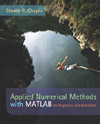Today’s engineering and science students routinely confront problems involving numerical
solution techniques. Sometimes these solutions are “automatically” generated by a software
package. In other cases, students must use programming skills to devise their own
solutions. In either case, knowledge of numerical methods is absolutely necessary for developing
and interpreting such solutions with wisdom and insight. This book is written to support a one-semester course in numerical methods. The
book’s primary audience are students who want to learn numerical methods to solve problems
in engineering and science. As such, the methods are motivated by problems rather
than by mathematics. That said, sufficient theory is provided so that students come away
with insight into the techniques and their shortcomings. MATLAB® provides a great environment for such a course. Although other environments
(e.g., Excel/VBA, Mathcad) or languages (e.g., Fortran 90, C++) could have been
chosen, MATLAB presently offers a nice combination of handy programming features
with powerful built-in numerical capabilities. On the one hand, its M-file programming environment
allows students to implement moderately complicated algorithms in a structured
and coherent fashion. On the other hand, its built-in numerical capabilities empower students
to solve more difficult problems without trying to “reinvent the wheel.” The first chapters provide introductory material including background on mathematical
modeling, MATLAB fundamentals, and error analysis. This is followed by chapters
dealing with several major areas of numerical methods: root location, linear algebraic
equations, least-squares regression, interpolation, integration, ordinary differential equations,
and eigenvalues. I have made a concerted effort to make this book as student-friendly as possible. Thus,
I’ve tried to keep my explanations straightforward and oriented practically. Although my
primary intent is to empower students by providing them with a sound introduction to numerical
problem solving, I have the ancillary objective of making this introduction exciting
and pleasurable. I believe that motivated students who enjoy engineering and science,
problem solving, and—yes—programming, will ultimately make better professionals. If
my book fosters enthusiasm and appreciation for this subject, I will consider the effort a
success. |



 2005 McGraw-Hill Higher Education
2005 McGraw-Hill Higher Education